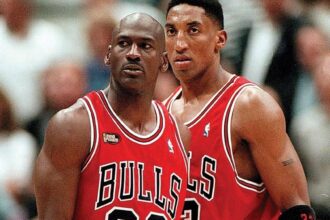The Brooklyn Nets suffered a disappointing 121-102 defeat at the hands of the Portland Trail Blazers on Tuesday night, extending their recent struggles as a team. Despite flashes of individual talent, the Nets appeared sluggish and disjointed throughout much of the game, failing to maintain the intensity needed to keep pace with a motivated Blazers squad. Fans hoping for a strong bounce-back performance were left frustrated as Brooklyn’s sleepwalk through the contest exposed lingering issues on both ends of the floor. This latest loss raises fresh questions about the Nets’ consistency and ability to close out games moving forward.
Brooklyn Nets Struggle to Find Rhythm in Disappointing Defeat to Portland
The Brooklyn Nets once again found themselves out of sync, unable to impose their game plan against a determined Portland Trail Blazers squad. From the opening tip, Brooklyn’s usual fluid ball movement and sharp shooting were noticeably absent, leading to a sluggish offensive performance. Key contributors struggled to find their groove, with inconsistent shooting from beyond the arc and untimely turnovers halting any momentum the Nets tried to build. Portland capitalized on every missed opportunity, pushing the pace and exploiting defensive lapses, ultimately controlling the game from start to finish.
- Kevin Durant managed 22 points but lacked the usual efficiency, shooting just 40% from the field.
- Spencer Dinwiddie battled through defensive pressure but was limited to 14 points, struggling to break down Portland’s backcourt.
- The bench unit failed to provide the necessary spark, contributing only 16 points combined.
| Statistic | Brooklyn Nets | Portland Trail Blazers |
|---|---|---|
| Field Goal % | 42.5% | 48.7% |
| 3-Point % | 31.3% | 38.9% |
| Turnovers | 15 | 9 |
| Bench Points | 16 | 29 |
Defensively, the Nets struggled to contain Portland’s sharpshooters, allowing multiple catch-and-shoot opportunities that kept the Trail Blazers comfortably ahead. The inability to close out on shooters and secure rebounds led to second-chance points that proved costly. With this loss, Brooklyn’s quest for consistency hits a new low, highlighting the urgent need for adjustments both in strategy and execution heading into the upcoming stretch of games.
Key Breakdown Areas Highlighted as Nets Fail to Contain Trail Blazers Offensive Push
The Nets struggled to keep pace with the Trail Blazers’ relentless offensive onslaught, revealing critical vulnerabilities in their defensive structure. Portland’s ability to exploit perimeter gaps and deliver pinpoint passes exposed a lack of communication and coordination among Brooklyn’s defenders. Key contributors like Damian Lillard and Anfernee Simons found consistent space to operate, often breaking down defenders off the dribble or hitting open shooters from beyond the arc. The Nets’ rotations were sluggish, allowing the Blazers to generate easy buckets in transition.
Offensively, Brooklyn failed to counter Portland’s energy and physicality, with stagnant ball movement and poor shot selection characterizing their attack. The team missed opportunities to capitalize on mismatches and failed to establish dominance in the paint, which translated into a significant deficit in second-chance points and overall scoring efficiency. Below is a snapshot of some core areas where the Nets fell short:
- Defensive breakdowns leading to open perimeter shots
- Lack of interior presence and rebound control
- Inconsistent offensive flow and poor shot decision-making
- Failure to limit turnovers under pressure
| Category | Nets | Trail Blazers |
|---|---|---|
| Opponent 3PT % Allowed | 39.5% | 48.7% |
| Defensive Rebounds | 32 | 41 |
| Turnovers Committed | 15 | 9 |
| Second Chance Points | 12 | 25 |
Improving Defensive Communication and Consistency Remain Crucial for Nets Moving Forward
Throughout the game, it became increasingly evident that the Nets’ defensive communication was disjointed, causing costly lapses that the Trail Blazers capitalized on. Broken coverages and missed rotations left shooters wide open, leading to an alarming decrease in defensive efficiency. To turn things around, Brooklyn must emphasize cohesive talk on the court, ensuring every player is aware of switches, screens, and help-side responsibilities. Defensive relentlessness cannot be a one-quarter effort; consistency from start to finish is mandatory for a team striving to compete in a stacked Eastern Conference.
The table below highlights some key defensive metrics from the game, underscoring the areas where the Nets fell short compared to Portland:
| Defensive Metric | Brooklyn Nets | Portland Trail Blazers |
|---|---|---|
| Defensive Rebounds | 30 | 38 |
| Opponent FG % | 49.5% | 44.2% |
| Forced Turnovers | 8 | 15 |
| Points Allowed in Paint | 58 | 42 |
Improving these numbers hinges not only on individual effort but also on strategic adjustments and a collective mindset shift. Defensive accountability, combined with sharper rotations and communication, will be essential for Brooklyn as they seek to minimize defensive lapses and maintain competitive consistency throughout the remainder of the season.
To Conclude
The Brooklyn Nets’ lackluster performance against the Portland Trail Blazers served as a stark reminder that consistency remains elusive for this team. With the 121-102 defeat, questions about the Nets’ ability to regroup and find their rhythm moving forward have only intensified. As the season progresses, Brooklyn will need to address these lapses quickly if they hope to keep pace in a competitive Eastern Conference. Nets fans will be watching closely to see how the team responds in their upcoming games.














